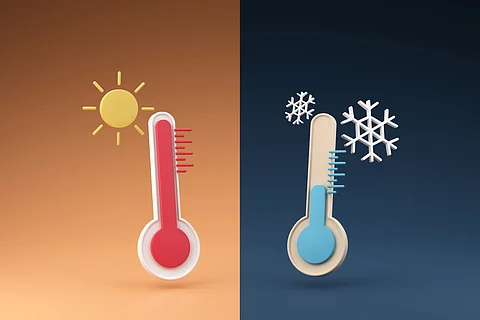

Over 60 per cent of the world has likely experienced sudden swings between extreme heat and cold over the past six decades, according to a new study.
These events, referred to as temperature flips, involve abrupt shifts from extreme warmth to cold or vice versa within a short period. Such rapid changes leave limited time for humans and ecosystems to respond and adapt, potentially leading to severe and even irreversible impacts on human health, infrastructure, air quality and plants, stated the research published in the journal Nature Communications.
One recent instance of a temperature flip occurred in April 2021, when Europe saw temperatures plummet from unseasonably warm to cold, resulting in widespread frost damage to crops.
“Although there is a rapidly growing literature on independent extreme warm (such as heatwaves) or cold events (such as cold spells), very little is known about the rapid flips between warm and cold events, including historical occurrences, underlying processes and their responses to global warming,” the study read.
This knowledge gap, the researchers warned, is concerning given how human, animal and plant health is vulnerable to sudden flips in temperature extremes under climate change.
The researchers analysed global data from 1961 to 2023 to assess the frequency, intensity and duration of these flip events. They also used climate models to project future trends under global warming scenarios.
Their findings showed that while temperature flips occurred less frequently in the tropics and polar regions, they were widespread in mid-latitudes, including East Asia, eastern North America and parts of South America, Africa and Australia.
One potential driver of this variability is the behaviour of a phenomenon called Rossby waves or planetary waves — large-scale atmospheric patterns caused by Earth’s rotation. These waves help redistribute heat from the tropics towards the poles and vice versa.
The study found that regions experiencing more frequent flips also tended to see stronger ones. This was particularly evident in East Asia and South America. Additionally, transition durations between warm and cold phases were shorter in mid-latitude regions.
Notably, the researchers observed that intense temperature flips may have begun as early as the early 20th century, which likely accelerated in the latter part of the century.
In terms of human exposure, Asia appeared to be at highest risk. “Densely populated regions (notably in South and Southeast Asia) have become increasingly exposed to more volatile temperatures, reinforcing the urgent need to mitigate the impacts of sudden and intense flips,” the researchers wrote in the study.
Looking ahead, the study estimated that the frequency of flip events could increase by 7-8 per cent between 2071 and 2100 relative to the 1961-1990 baseline. Intensity was projected to rise by 7.16-7.32 per cent, while transition duration could shorten by 2.47-3.24 per cent over the same period.
Global population exposure to these events is expected to more than double, with low-income countries bearing the heaviest burden — facing exposure levels 4 to 6.5 times higher than the global average in all scenarios. Lower-middle-income nations followed closely behind, with a population exposure going up to almost 1.3 times above the global average.
The researchers warn that without mitigation efforts, climate change will wreak havoc. “Climate change leads to more frequent and more severe temperature flips, such as warm winter days followed by sudden cold snaps can cause unpredictable energy demands for heating, thereby increasing unevenly across different income-level regions and elevating the risks of energy shortages in some low-income regions,” the researchers wrote, calling for effective measures to tackle and respond to rapid temperature flips.